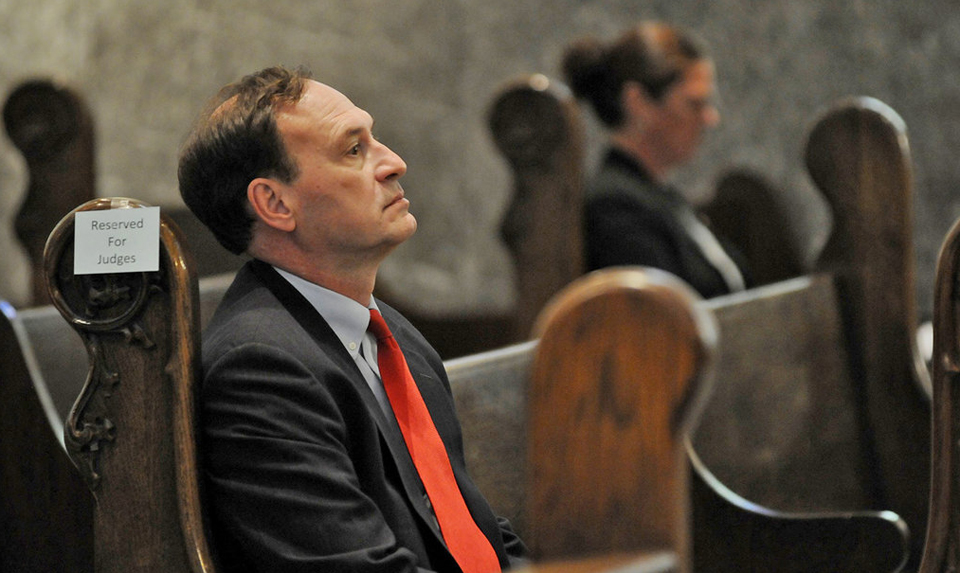
This is the fourth and last of a series. In this series thus far on the Supreme Court’s ruling in the Janus case, I have analyzed the ways Justice Samuel Alito’s arguments have re-framed, in ways that distort and actually undermine, America’s supposedly sacred principles of free speech and democracy. While the lion’s share of the coverage of this case has focused on the outcome itself and how it threatens the financial and thus political wherewithal of unions to represent workers and their interests, Alito’s arguments themselves are profoundly material for us to understand because, if you read any Supreme Court decision, you will see that future courts look not just to the decision itself but to the reasoning behind the decision as a precedent that requires a high-bar to overturn.
Thus, at least in this very important jurisprudential context, how Alito re-defines free speech and democracy as their opposites can have long-standing consequences as this political vocabulary informs social policy going forward indefinitely.
In addition to free speech and democracy, Alito’s arguments also turn the foundational American concept and value of equality on its head, and it is important to understand how the Janus ruling fits in as one powerful and key salvo in the larger effort by the Supreme Court and the Trump administration to ratify and enforce—indeed, promote—social, political, and economic inequality in a U.S. society characterized by ever-increasing inequality.
If you happened to think America and its institutions were engaged in a cooperative effort to a create a more equal society but failing, consider then the Janus decision in the context of surrounding events that highlight Alito’s rhetorical legerdemain in turning equality into inequality as part of a larger political and legal project in U.S. institutional life.
Think back to June 2013 when the Supreme Court struck down a key part of the 1965 Voting Rights Act that determined which cities, counties, and states needed to seek approval from the Department of Justice before changing their voting laws. When first implemented, the act targeted particular locales with a high degree of racial polarization and a record of institutionalized racially discriminatory practices. The Supreme Court’s majority ruling rationalized that the provision was not based on “current conditions,” suggesting that racial discrimination and inequality are now relics of the past in the identified regions. This ruling gave rise to Justice Ruth Bader Ginsburg’s famous quip in her dissent that the ruling was “like throwing away your umbrella in a rainstorm because you are not getting wet.” Her dissent went on to rattle off eight instances of race-based voter discrimination between 1990 and 2006 in states such as Georgia, Alabama, and Mississippi, states previously subjected to the conditions of the 1965 Voting Rights Act.
What we see in this case is the Supreme Court’s reversal of a key piece of legislation designed to address social and political inequality, to level the playing field, so to speak, by providing equal access in voting and equal participation in the electoral process more generally. In short, in refusing to consider the historical actualities or “current conditions” of race-based voter discrimination and inequality, the Court effectively endorsed racial inequality and exclusion by enabling the conditions that enforce them and removing measures to prevent or remedy such inequality and exclusion.
Sound familiar? Jump ahead to early July 2018 when the Trump administration rescinded policies from the Obama administration that called on universities to consider race as a factor in admissions in order to diversify campuses. Instead, the Trump administration argued that Obama’s executive orders exceeded the Constitution and called for a return to the “race-blind” admissions practices championed under the George W. Bush administration.
Ignoring the already-existing racial inequalities, Trump spokespeople such as Education Secretary Betsy DeVos re-define equality in a way that normalizes, indeed embraces, racial inequality as consistent with the vision of an equal society. DeVos, for example, offered this comment on the reversal: “The Supreme Court has determined what affirmative action policies are constitutional, and the court’s written decisions are the best guide for navigating this complex issue. Schools should continue to offer equal opportunities for all students while abiding by the law.”
One only has to review the long record of African American lives lost to acts of police violence to know that Black lives are in fact devalued—or don’t matter in the eyes of our dominant culture; or look at our recalcitrantly segregated society or to any of the instances Justice Ginsburg enumerates in her 2013 dissent to know that people of color have unequal access to educational, political, and employment opportunities in the United States. So, insisting as DeVos does that equality or equal opportunity is created by ignoring “race’—or more accurately the reality of racial inequality—simply and insidiously serves to ratify inequality in the name of creating equality.
I bring up these examples because the Janus ruling, which in my view has received much less serious attention and discussion—just as generally class inequality and working-class or labor issues receive less attention relative to the more charged issues of race in America—is part and parcel of this larger project of disabling measures designed to foster greater equality and thus enforcing and enabling the forces that continue to generate and increase inequality socially, politically, and economically.
For example, as I argued in Part III of this series, Alito, consistent with the 2013 SCOTUS ruling referenced above as well as the Trump reversal of affirmative action policy in university admissions, refuses to recognize the already-existing conditions of inequality in the workplace between workers and management or owners, in short between labor and capital. As I pointed out, Alito ignores the fact—which he must full well know—that workers do not have the rights of free speech in the workplace and that workplace democracy is not a reality.
The very point of unions, of workers collectively organizing to have a voice and accrue a measure of power in the workplace, is to attempt to level the playing field somewhat between those who own the means of production and those who work for the owners and are subject otherwise to their decisions and rules. Unions constituted for workers the collective voice and power to have some role—often still not an equal one–in deciding the rules and conditions regulating their work life in a capitalist world they don’t own and in which property or ownership rights tend to supersede other rights. The individual, to whom Alito gives rights against and over that of collective workers, really has little power in the workplace without a union to represent workers collectively. In effect, the victory for individual rights in this context is a pyrrhic one, and both the individual worker and the collective body of workers lose rights.
Again, the key point to be made here is that Alito’s decision, like these others, reinforces the conditions of inequality—and provides fertile conditions for furthering them—in guise of protecting democratic and constitutional rights. Here it takes place in the arena of the workplace and more in the domain of class politics, to which Americans tend to devote less attention than they do the more charged and overt racial politics despite the material impact on their lives. Nonetheless, we must recognize the Janus decision as consistent with and part of an overall project to undermine equality, turn it on its head. The ruling is one link in this chain I’ve been presenting.
Moreover, as I argued in Part II of this series, Alito absolutely also ignores, in a rather bad faith manner, the realities of the material economic and political contexts he invokes to justify his decision, just as the Court did in its 2013 reversal of elements of the Voting Rights Act. Part of Alito’s argument for workers in a unionized workplace to not have to pay fair share dues is that collective bargaining constitutes political speech itself. He invokes conditions in the state of Illinois in which he argues, based on hearsay, that state budgets are strained because of the pension deficits and costs for state workers and because of overly generous benefits.
In short, his lack of analysis blames state workers and their contracts for the state’s financial woes, and his ruling enables and, indeed, validates states to balance budgets through assaulting the wages and benefits of state workers. Here, again, his lack of analysis highlights an ideological predilection to enforce and further inequality by paving the way to make conditions worse for those already on the bottom.
Consider this fact: Two-thirds of Illinois corporations pay no state income tax, and Illinois has one of the most regressive state income tax system in the nation. Moreover, since the state of Illinois opted out of the Social Security program at its inception, the state has not had to pay into that system for its workers—saving it hundreds of billions of dollars over time—whereas the pension debts are a result of the state not paying into the system year after year, not overly generous benefits.
So, once again, Alito’s argument “fudges” reality, to put it politely, and in doing so he sides with the owners of the world against the workers, allowing for the furthering of the political, economic, and social inequality that already exists between capital and labor, between employers and workers.
Whether we speak in terms of race or class—or more preferably their intertwined dimensions—we have to recognize the power dynamics at work in U.S. society that is furthering inequality in all its dimensions. The Janus decision, like others, is part of this trajectory of power that ideologically cloaks itself in the language of equality and constitutionality, while undermining our most sacred yet unrealized values of democracy, freedom, and equality.









